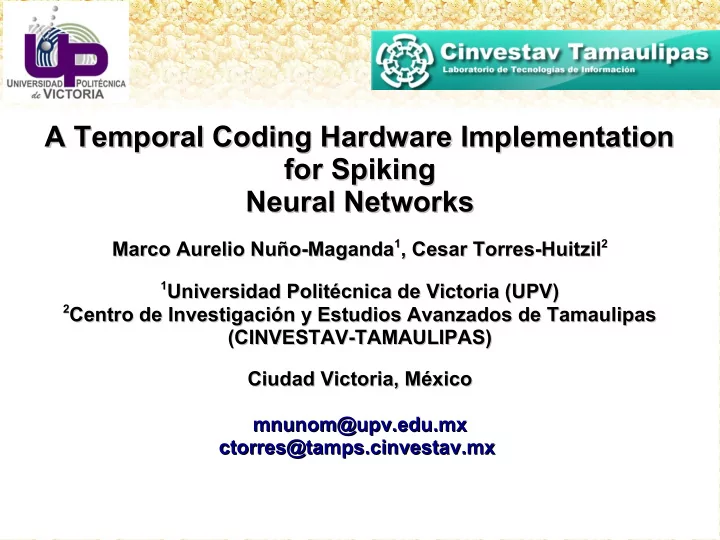

A Temporal Coding Hardware Implementation A Temporal Coding Hardware Implementation for Spiking for Spiking Neural Networks Neural Networks Marco Aurelio Nuño-Maganda 1 1 , Cesar Torres-Huitzil , Cesar Torres-Huitzil 2 2 Marco Aurelio Nuño-Maganda 1 Universidad Politécnica de Victoria (UPV) 1 Universidad Politécnica de Victoria (UPV) 2 Centro de Investigación y Estudios Avanzados de Tamaulipas 2 Centro de Investigación y Estudios Avanzados de Tamaulipas (CINVESTAV-TAMAULIPAS) (CINVESTAV-TAMAULIPAS) Ciudad Victoria, México Ciudad Victoria, México mnunom@upv.edu.mx mnunom@upv.edu.mx ctorres@tamps.cinvestav.mx ctorres@tamps.cinvestav.mx
Outline 1. Introduction 2. GRF-Based Temporal Coding 3. Hardware Implementation 4. Results 5. Discussion 6. Conclusion and Future Work
1. Introduction Spiking Neural Networks (SNNs) states that information among neurons is interchanged via pulses or spikes. SNNs have the ability for processing static patterns and dynamic patterns that exhibits rich temporal characteristics. Important issue: information coding.
1. Introduction Main approaches: Rate coding. The information is encoded in the neuron ring time. Temporal coding. The information is encoded by the timing of spike Population coding. The information is encoded by the activity of different pools of neurons. There are strong debates about the question of which neural codes are used for biological neural systems There is a growing evidence that the brain may use all of them
2. GRF-basedTemporal Coding REFERENCE V NEURON A technique for coding input variables GRF 0 (V) Inspired in the Local GRF 1 (V) Receptive Fields of GRF 2 (V) Biological Neurons Each dimension is GRF 3 (V) associated to a t graded overlapping t = 0 t = t MAX profile. Arguments in Favor Key parameters: Not sensitive to scale width and center changes Performs a sparse coding position
2. GRF-basedTemporal Coding Application: Multilayer FF-SNNs The GRF output in the input firing time of a neuron in one Feed-Forward SNN. Each connection is divided in a set of multiple synaptic connections Weight and delays associated to each terminal
2. Gaussian Receptive Fields (GRFs) for Neuron Coding A real value is encoded by an array of receptive fields. For a variable with a range , a set of m Gaussian Receptive Fields are used. The center is given by: And the width σ of each RF neuron i is given by: Where the proposed value for β belongs to the range [1,2]
2. Gaussian Receptive Fields Coding Examples Steps for coding a set of input values: Each input value is normalized. Each normalized value is evaluated in each GRF. The evaluation obtained in each GRF is assigned to one single input neuron.
2. Gaussian Receptive Fields Issues to be addressed Hardware resource simplification Scalability and Flexibility Data representation Types of Parallelism
3. Hardware Implementation The Input data set is stored in external memory (accessed through the External Memory Unit - EMU) The input data set is analyzed for obtaining relevant information (Data Distribution Unit DDU) The Global Control Unit (GCU) generates the synchronization signals for the components
3. Hardware Implementation The each sample of the dataset is sent to the Gaussian Modules (GMs) for obtaining the coding. Each GM has the following input ports: Data Port (DP) - Contains the data to be processed. Control Port (CP) - Contains several synchronization signals
3. Hardware Implementation The main components of the GM are: Control Unit - Min Register (MR) - Bank of Centroids (BCs) Integer Part Register (IPR) Fractional Part Register (FPR) Bank of Reciprocals (BRs)
3. Hardware Implementation Other components of the GM are: Reciprocal Register (RR) - N-Power of FP Register (NPFPR) Exponential of 1 Register (E1R) Exponential Register (ER)
4. Results Tools for HW implementation: Target FPGA: Virtex II Pro Target Board: Alphadata AXM-XPL Handel-C modeling VHDL synthesizing Tools for SW implementation: PC with Pentium IV Processor running at 3.66 GHz. Visual C++ Implementation of GMs with several EMs –Al least 4 EMs with each GMs
4. Results – Hardware Platform Resource available in the target FPGA device: Target FPGA platform (Alphadata ADMXPL PMC board)
4. Results - Performance Both software and hardware implementations are compared Several dataset sizes (rows and columns) are compared There is a performance improvement of at least 50x when using moderate hardware resources
4. Results - Presicion For comparing both SW and HW implementation, the MSE metric was used The architecture is flexible for supporting several precisions Several bit precision (for fractional part) have been evaluated The 8-bit precision is enough for several machine learning applications
4. Results – Hardware utilization Hardware resources and maximum clock frequency for each variation of the proposed architecture were obtained
5. Discusion The base architecture is designed to be flexible for processing several GRFs with potential applications in different domains. The proposed architecture is designed to work with several columns of the source dataset. The importance of computing in parallel the temporal coding consists on the possibility of integrating the proposed architecture with any SNN in a pipelined fashion,
6. Conclusion and Future Directions At least 50X is obtained with the proposed architecture. Several performance-resource trade-offs can be established, since dedicated multiplier resources are the most demanded ones in the current implementation. The integration of the proposed architecture with other processing modules for a complete implementation of SNNs will be analyzed.
Thank you ! Thank you ! Marco Nuno-Maganda Marco Nuno-Maganda mnunom@upv.edu.mx mnunom@upv.edu.mx
Recommend
More recommend